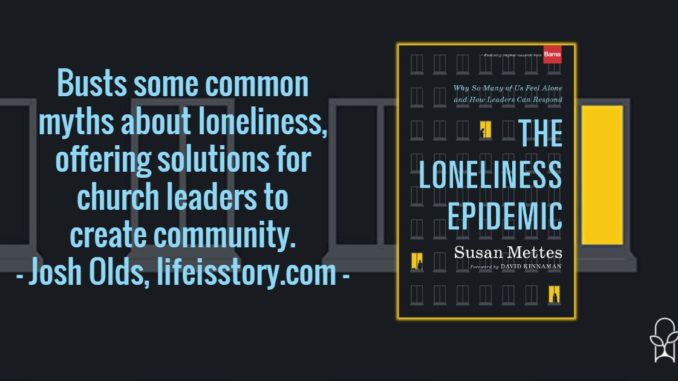
Published by Brazos Press on November 2, 2021
Genres: Non-Fiction, Christian Life, Leadership, Work
Buy on Amazon
Goodreads

What makes people lonely? And how can Christian communities better minister to the lonely? In The Loneliness Epidemic, behavioral scientist and researcher Susan Mettes explores those questions and more.
Guided by current research from Barna Group, Mettes illustrates the profound physical, emotional, and social toll of loneliness in our country. Surprisingly, her research shows that it is not the oldest Americans but the youngest adults who are loneliest, and that social media can actually play a positive role in alleviating loneliness. Mettes highlights the role that belonging, friendship, closeness, and expectations play in preventing it. She also offers meaningful ways the church can minister to lonely people, going far beyond simplistic solutions--like helping them meet new people--to addressing their inner lives and the God who understands them.
With practical and highly applicable tips, this book is an invaluable tool for anyone--ministry leaders, parents, friends--trying to help someone who feels alone. Readers will emerge better able to deal with their own loneliness and to help alleviate the loneliness of others. Foreword by Barna Group president David Kinnaman.
When it comes to being lonely, you’re not alone. The Loneliness Epidemic begins with the numbers. 36% adults say they feel lonely sometimes or all the time. 34% of Americans aged 18-35 say they feel lonely frequently. In a recent Cigna study utilizing the UCLA Loneliness Scale, the majority of respondents would have been classified as lonely. Susan Mettes defines loneliness as “the distress someone feels when their social connections don’t meet their need for emotional intimacy.” Through the first couple of chapters, Mettes introduces us to the problem of loneliness: how it spreads, the physical and mental effects it can have, and what steps we can take to prevent it.
Before we get too far into solutions, however, The Loneliness Epidemic takes some time to bust some common myths regarding loneliness. Most of the research in The Loneliness Epidemic came from two surveys conducted by Barna Group. Each survey had about a thousand participants. One was completed between Feb 18 – March 4, 2020—right before COVID lockdowns. The second took place between April 28 – May 11, 2020. This is an important because it’s unclear, at least in the book, what difference might be between pre- and post- COVID responses. Obviously, Barna couldn’t predict a global lockdown, but it would have been interesting to see how respondents to the Feb-Mar survey might have answered in the Apr-May survey. The Loneliness Epidemic isn’t a book about the loneliness wrought by COVID, but given their timeframes for research, it is a glaring variable that I think should have received more attention.
The stereotypes that Mettes lists are: age (older adults are the loneliest), romance (people in happy romantic relationships aren’t lonely), insecurity (poor social skills cause loneliness), social media (time spent on social media causes loneliness), faith (churchgoing makes one less lonely), privacy (if people are paying attention to you, you won’t feel lonely). In each case, the research shows this to be a myth. It’s younger adults, navigating the changing social structure from childhood to adulthood, that are most lonely (or most likely to admit it). Neither romance nor churchgoing negates loneliness entirely. And so on.
The last part of the book then looks toward solutions. Mettes highlights the three areas of belonging, closeness, and expectations. Belonging is simply about finding a group to spend time and share ideas with. The book doesn’t explain it in these terms, but I like to use the concepts of shared space, shared ideas, and shared joys. Some friends are friends of location. You’re friends with them because they live down the street, are coworkers, attend your church. Other friends are likeminded, or enjoy the same foods or sports or television shows. It’s about anything that connects two people together. Closeness comes with the development of those relationships and involving hospitality, physical touch, and neighborliness. It’s about being in each other’s homes and group chats and cultivating connectedness. Expectation is about understanding other people and having a reasonable idea of what friendship is.
In the end, The Loneliness Epidemic is a bit generic. Nothing in it seemed unexpected or revolutionary. Then again, I am currently writing a doctoral dissertation on clergy loneliness so I have been absolutely steeped in the literature and that may contribute to the feeling. The device of myth-busting helps break down the commonly-held assumptions in a clear way. The solutions are also clear and simple—but maybe not as robust as I would have liked. The final chapter of The Loneliness Epidemic lists different ways church leaders can break the cycle and that chapter really should have been expanded to a whole section. Mettes focuses on the problem, sets some ideas for solutions in place, but I would liked to have seen more about how those solutions should play out.
